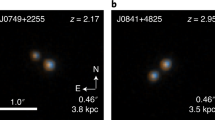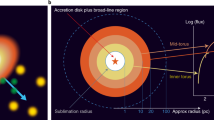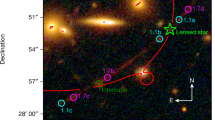Abstract
All cosmological models of structure formation predict the existence of a widespread population of dual supermassive black holes in-spiralling inside their common host galaxy, eventually merging and giving rise to intense gravitational waves. These systems can be identified as dual active galactic nuclei (AGNs) at kiloparsec separations, but only very few have been confirmed at z > 0.5. The appearance of multiple AGNs at small angular separations can also be due to gravitational lensing of single AGNs, which are themselves very important systems for many astrophysical topics. Here we present a novel technique, dubbed the Gaia multipeak method, to obtain large and reliable samples of dual/lensed AGN candidates with sub-arcsec separations by looking for AGNs showing multiple peaks in the light profiles observed by the Gaia satellite. All of the Gaia multipeak method-selected sources with high-resolution images (26 from the Hubble Space Telescope archive and 5 from dedicated adaptive-optics-assisted imaging at the Large Binocular Telescope) show multiple components with sub-arcsec separation pointing toward a very high reliability of the method. By sampling separations down to ~2 kpc at z > 1, this method allows us to probe the physical processes that drive the in-spiralling of a pair of supermassive black holes inside a single galaxy.
This is a preview of subscription content, access via your institution
Access options
Access Nature and 54 other Nature Portfolio journals
Get Nature+, our best-value online-access subscription
$29.99 / 30 days
cancel any time
Subscribe to this journal
Receive 12 digital issues and online access to articles
$119.00 per year
only $9.92 per issue
Buy this article
- Purchase on Springer Link
- Instant access to full article PDF
Prices may be subject to local taxes which are calculated during checkout




Similar content being viewed by others
Data availability
The Gaia catalogue is publicly available at https://gea.esac.esa.int/archive/. The HST data are publicly available via the Mikulski Archive for Space Telescopes at https://archive.stsci.edu. The Milliquas catalogue of the parent AGNs is available at https://heasarc.gsfc.nasa.gov/W3Browse/all/milliquas.html. SDSS spectra can be downloaded from https://www.sdss.org/dr16.
References
Colpi, M. Massive binary black holes in galactic nuclei and their path to coalescence. Space Sci. Rev. 183, 189 (2014).
Volonteri, M., Habouzit, M. & Colpi, M. The origins of massive black holes. Nat. Rev. Phys. 3, 732 (2021).
Koss, M. J. et al. A population of luminous accreting black holes with hidden mergers. Nature 563, 214 (2018).
Liu, X. et al. Hubble Space Telescope Wide Field Camera 3 identifies an r = 1 Kpc dual active galactic nucleus in the minor galaxy merger SDSS J0924+0510 at z = 0.1495. Astrophys. J. 862, 29 (2018).
Severgnini, P. et al. A possible sub-kiloparsec dual AGN buried behind the galaxy curtain. Astron. Astrophys. 646, A153 (2021).
De Rosa, A. et al. The quest for dual and binary supermassive black holes: a multi-messenger view. N. Astron. Rev. 86, 101525 (2019).
Silverman, J. D. et al. Dual supermassive black holes at close separation revealed by the Hyper Suprime-Cam Subaru Strategic Program. Astrophys. J. 899, 154 (2020).
Chen, Y.-C. Small-scale double quasars discovered in the DECam Legacy Survey. Preprint at https://arxiv.org/abs/2109.06881 (2021).
Schechter, P. L. et al. First lensed quasar systems from the VST-ATLAS Survey: one quad, two doubles, and two pairs of lensless twins. Astron. J. 153, 219 (2017).
Anguita, T. et al. The STRong lensing Insights into the Dark Energy Survey (STRIDES) 2016 follow-up campaign - II. New quasar lenses from double component fitting. Mon. Not. R. Astron. Soc. 480, 5017 (2018).
Lemon, C. et al. J1721+8842: a gravitationally lensed binary quasar with a proximate damped Lyman-α absorber. Astron. Astrophys. 657, 113 (2022).
Amante, M. H. et al. Testing dark energy models with a new sample of strong-lensing systems. Mon. Not. R. Astron. Soc. 498, 6013 (2020).
Wong, K. C. et al. H0LiCOW—XIII. A 2.4 per cent measurement of H0 from lensed quasars: 5.3σ tension between early- and late-Universe probes. Mon. Not. R. Astron. Soc. 498, 1420 (2020).
Feruglio, C. et al. On the discovery of fast molecular gas in the UFO/BAL quasar APM 08279+5255 at z = 3.912. Astron. Astrophys. 608, A30 (2017).
Tozzi, G. et al. Connecting X-ray nuclear winds with galaxy-scale ionised outflows in two z ∼ 1.5 lensed quasars. Astron. Astrophys. 648, A99 (2021).
Shen, Y. et al. A hidden population of high-redshift double quasars unveiled by astrometry. Nat. Astron 5, 569–574 (2021).
Junkkarinen, V. et al. LBQS 0103-2753: a 0.3″ binary quasar. Astrophys. J. 549, L155 (2001).
Rowell, N. et al. Gaia Early Data Release 3. Modelling and calibration of Gaia's point and line spread functions. Astron. Astrophys. 649, A11 (2021).
Hambly, N. C. et al. Gaia Data Release 2. Calibration and mitigation of electronic offset effects in the data. Astron. Astrophys. 616, A15 (2018).
Gaia Collaboration, Brown. et al. Gaia Early Data Release 3. Summary of the contents and survey properties. Astron. Astrophys. 649, A1 (2021).
Riello, M. et al. Gaia Early Data Release 3. Photometric content and validation. Astron. Astrophys. 649, A3 (2021).
Lindegren, L. et al. Gaia Early Data Release 3. The astrometric solution. Astron. Astrophys. 649, A2 (2021).
Fabricius, C. et al. Gaia Early Data Release 3. Catalogue validation. Astron. Astrophys. 649, A5 (2021).
Chen, Y.-C. et al. Varstrometry for off-nucleus and dual sub-kpc AGN (VODKA): Hubble Space Telescope discovers double quasars. Astrophys. J. 925, 162C (2022).
Lieu, R. Strong-lensing time delay: a new way of measuring cosmic shear. Astrophys. J. 674, 75 (2008).
Grier, C. J. et al. The Sloan Digital Sky Survey reverberation mapping project: Hα and Hβ reverberation measurements from first-year spectroscopy and photometry. Astrophys. J. 851, 21 (2017).
Kaspi, S. et al. Taking a long look: a two-decade reverberation mapping study of high-luminosity quasars. Astrophys. J. 915, 129 (2021).
Girardi, L. et al. Theoretical isochrones in several photometric systems. I. Johnson–Cousins–Glass, HST/WFPC2, HST/NICMOS, Washington, and ESO Imaging Survey filter sets. Astron. Astrophys. 391, 195 (2002).
Lyke, B. W. et al. The Sloan Digital Sky Survey quasar catalog: sixteenth data release. Astrophys. J. Suppl. Ser. 250, 8 (2020).
Maraston, C. et al. Stellar population models based on the SDSS-IV MaStar library of stellar spectra—I. Intermediate-age/old models. Mon. Not. R. Astron. Soc. 496, 2962 (2020).
Li, K., Ballantyne, D. R. & Bogdanović, T. The detectability of kiloparsec-scale dual active galactic nuclei: the impact of galactic structure and black hole orbital properties. Astrophys. J. 916, 110 (2021).
Steinborn, L. K. et al. Origin and properties of dual and offset active galactic nuclei in a cosmological simulation at z = 2. Mon. Not. R. Astron. Soc. 458, 1013 (2016).
Eftekharzadeh, S. et al. Clustering of intermediate redshift quasars using the final SDSS III-BOSS sample. Mon. Not. R. Astron. Soc. 453, 2779 (2015).
Rosas-Guevara, Y. M. et al. The abundances and properties of dual AGN and their host galaxies in the EAGLE simulations. Mon. Not. R. Astron. Soc. 483, 2712 (2019).
Comerford, J. M. et al. Inspiralling supermassive black holes: a new signpost for galaxy mergers. Astrophys. J. 698, 956 (2009).
Volonteri, M. et al. The cosmic evolution of massive black holes in the Horizon-AGN simulation. Mon. Not. R. Astron. Soc. 460, 2979 (2016).
Van Wassenhove, S. et al. Observability of dual active galactic nuclei in merging galaxies. Astrophys. J. 748, L7 (2012).
Capelo, P. R. et al. A survey of dual active galactic nuclei in simulations of galaxy mergers: frequency and properties. Mon. Not. R. Astron. Soc. 469, 4437 (2017).
Blecha, L. et al. The power of infrared AGN selection in mergers: a theoretical study. Mon. Not. R. Astron. Soc. 478, 3056 (2018).
Biava, N. et al. The lifetime of binary black holes in Sérsic galaxy models. Mon. Not. R. Astron. Soc. 487, 4985 (2019).
Begelman, M. C., Blandford, R. D. & Rees, M. J. Massive black hole binaries in active galactic nuclei. Nature 287, 307 (1980).
Yu, Q. Evolution of massive binary black holes. Mon. Not. R. Astron. Soc. 331, 935 (2002).
Tamfal, T. et al. Formation of LISA black hole binaries in merging dwarf galaxies: the imprint of dark matter. Astrophys. J. 864, L19 (2018).
Tamburello, V. et al. Supermassive black hole pairs in clumpy galaxies at high redshift: delayed binary formation and concurrent mass growth. Mon. Not. R. Astron. Soc. 464, 2952 (2017).
Rauch, M. et al. Small-scale structure at high redshift. III. The clumpiness of the intergalactic medium on subkiloparsec scales. Astrophys. J. 562, 76 (2001).
Tejos, N. et al. Telltale signs of metal recycling in the circumgalactic medium of a z 0.77 galaxy. Mon. Not. R. Astron. Soc. 507, 663 (2021).
Mortensen, K. et al. Kinematics of the circumgalactic medium of a z = 0.77 galaxy from Mg ii tomography. Astrophys. J. 914, 92 (2021).
Peng, C. Y. et al. Probing the coevolution of supermassive black holes and galaxies using gravitationally lensed quasar hosts. Astrophys. J. 649, 616 (2006).
Casadio, C. et al. SMILE: Search for MIlli-LEnses. Mon. Not. R. Astron. Soc. 507, L6 (2021).
Kochaneck, C. in Gravitational Lensing: Strong, Weak and Micro. Saas-Fee Advanced Course 33 (eds Meylan, G. et al.) 91-268 (Springer, 2006).
Gaia Collaboration, Prusti. et al. The Gaia mission. Astron. Astrophys. 595, A1 (2016).
Pancino, E. et al. Globular clusters with Gaia. Mon. Not. R. Astron. Soc. 467, 412 (2017).
Flesch, E. W. The Million Quasars (Milliquas) v7.2 Catalogue, now with VLASS associations. The inclusion of SDSS-DR16Q quasars is detailed. Preprint at https://arxiv.org/abs/2105.12985 (2021).
Mandel, H. et al. LUCIFER: a NIR spectrograph and imager for the LBT. Astron. Nachr. 328, 626 (2007).
Pinna, E. et al. SOUL: the single conjugated adaptive optics upgrade for LBT adaptive optics systems. Proc. SPIE Int. Soc. Opt. Eng. 9909, 99093V (2016).
Pinna, E. et al. Bringing SOUL on sky. Preprint at https://arxiv.org/abs/2101.07091 (2021).
Hwang, H.-C. et al. Varstrometry for off-nucleus and dual subkiloparsec AGN (VODKA): methodology and initial results with Gaia DR2. Astrophys. J. 888, 73 (2020).
Calzetti, D. et al. The dust content and opacity of actively star-forming galaxies. Astrophys. J. 533, 682 (2000).
Acknowledgements
This work has made use of data from the European Space Agency (ESA) mission Gaia (https://www.cosmos.esa.int/gaia), processed by the Gaia Data Processing and Analysis Consortium (DPAC, https://www.cosmos.esa.int/web/gaia/dpac/consortium). Funding for the DPAC has been provided by national institutions, in particular the institutions participating in the Gaia Multilateral Agreement. This research is based on observations made with the NASA/ESA Hubble Space Telescope obtained from the Space Telescope Science Institute, which is operated by the Association of Universities for Research in Astronomy, Inc., under NASA contract NAS 5–26555. Funding for the SDSS has been provided by the Alfred P. Sloan Foundation, the US Department of Energy Office of Science and the Participating Institutions. SDSS acknowledges support and resources from the Center for High-Performance Computing at the University of Utah. The SDSS web site is www.sdss.org. We are grateful to all the LBT staff that performed the requested observations. The LBT is an international collaboration among institutions in the United States, Italy and Germany. LBT Corporation partners are: The University of Arizona on behalf of the Arizona Board of Regents; Istituto Nazionale di Astrofisica, Italy; LBT Beteiligungsgesellschaft, Germany, representing the Max-Planck Society, The Leibniz Institute for Astrophysics Potsdam, and Heidelberg University; The Ohio State University, representing OSU, University of Notre Dame, University of Minnesota and University of Virginia.
Author information
Authors and Affiliations
Contributions
F.M. designed and coordinated the work, prepared the figures and drafted the manuscript. E. Pancino provided the knowledge of the Gaia database parameters. All authors have contributed to the analysis and interpretation of the data and to the final text.
Corresponding author
Ethics declarations
Competing interests
The authors declare no competing interests.
Peer review
Peer review information
Nature Astronomy thanks the anonymous reviewers for their contribution to the peer review of this work.
Additional information
Publisher’s note Springer Nature remains neutral with regard to jurisdictional claims in published maps and institutional affiliations.
Extended data
Extended Data Fig. 1 Separation sensitivity of the GMP method.
Estimated fraction of pairs that are not split in the Gaia EDR3 catalogue as a function of separation. To consider pairs similar to the dual AGNs, we limit the luminosity of the primary and secondary objects to 17 < G < 20 and 17 < G < 21, respectively. The dotted line shows an analytic fit to the curve. Right: Values of ipd_frac_multi_peak for the primary component of split pairs for the same magnitude ranges as in the left panel. The solid line shows median values as a function of separation, while the shaded regions show the 25%–75% and 10%−90% distributions. The blue horizontal dashed line shows the threshold used for this work.
Extended Data Fig. 2 Distribution of ipd_frac_multi_peak of the 221 candidates of the primary sample vs. redshift, colour-coded with their G-band magnitude.
For clarity, values of the ipd_frac_multi_peak larger than 40% are plotted at this value. The grayscale image shows the distribution of the input catalogue of AGN, strongly peaked at very low values of ipd_frac_multi_peak. The black diamonds identify the objects with archival HST images.
Extended Data Fig. 3 Values of the ipd_frac_multi_peak (presence of multiple peaks) as a function of RUWE (normalised extra astrometric jitter) for the 221 systems of the primary sample, colour-coded with their G-band magnitude.
For clarity, objects with values of RUWE larger than 3.5 and of ipd_frac_multi_peak larger than 40% are plotted at these values, respectively. The grayscale image shows the distribution of the input catalogue of AGN, peaked at low values of ipd_frac_multi_peak but spanning a significant range of RUWE. The dotted line shows the threshold RUWE = 1.4. The black diamonds identify the objects with archival HST images.
Rights and permissions
Springer Nature or its licensor holds exclusive rights to this article under a publishing agreement with the author(s) or other rightsholder(s); author self-archiving of the accepted manuscript version of this article is solely governed by the terms of such publishing agreement and applicable law.
About this article
Cite this article
Mannucci, F., Pancino, E., Belfiore, F. et al. Unveiling the population of dual and lensed active galactic nuclei at sub-arcsec separations. Nat Astron 6, 1185–1192 (2022). https://doi.org/10.1038/s41550-022-01761-5
Received:
Accepted:
Published:
Issue Date:
DOI: https://doi.org/10.1038/s41550-022-01761-5
This article is cited by
-
Searching for Strong Gravitational Lenses
Space Science Reviews (2024)



